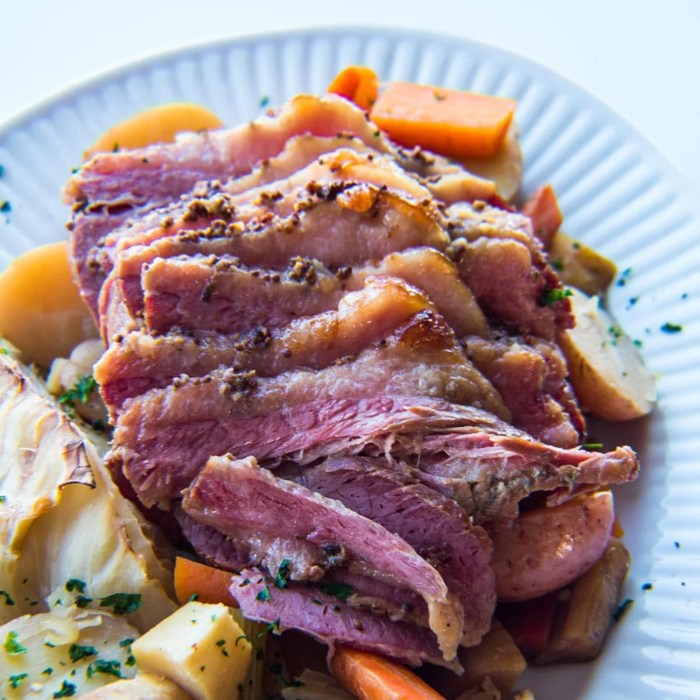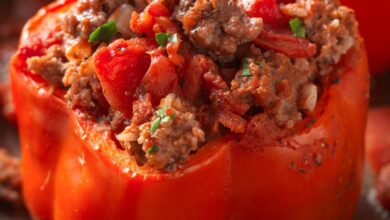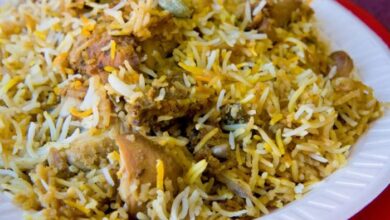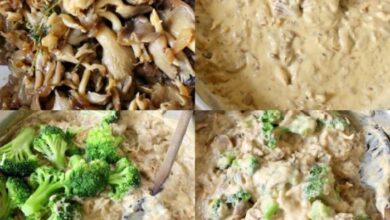
Baked Corned Beef and Cabbage: A Classic Comfort Food
Baked corned beef and cabbage is a dish that evokes memories of family gatherings, hearty meals, and the comforting aromas of home cooking. It’s a classic comfort food that has been enjoyed for generations, and its origins can be traced back to the Irish diaspora in the United States.
The dish itself is a testament to the ingenuity of those who sought to create a filling and satisfying meal from readily available ingredients. Corned beef, a preserved cut of beef that was once a staple in the Irish diet, is the star of the show.
The cabbage, a versatile and affordable vegetable, provides a delightful counterpoint to the richness of the meat. Together, they create a symphony of flavors that is both familiar and comforting.
History and Origins of Baked Corned Beef and Cabbage
Baked corned beef and cabbage, a hearty and comforting dish, has a rich history intertwined with Irish heritage and the immigrant experience in America. This iconic meal has evolved over time, becoming a staple in many households, especially during St.
Patrick’s Day celebrations.
Origins and Cultural Significance
The origins of corned beef and cabbage can be traced back to Ireland, where salt-cured beef, known as “corned beef,” was a common food source. This method of preserving meat was essential in a climate where refrigeration was unavailable. Cabbage, a readily available and inexpensive vegetable, was often paired with corned beef, creating a simple and satisfying meal.
The dish’s cultural significance lies in its connection to Irish immigrants who brought their culinary traditions to America in the 19th century. Corned beef and cabbage became a symbol of their heritage and a way to maintain their cultural identity in a new land.
Baked corned beef and cabbage is a classic comfort food, but sometimes you crave something a little lighter and faster. That’s where a quick and easy skillet lasagna comes in! It’s a delicious and satisfying meal that’s perfect for a busy weeknight.
And, if you’re still craving that corned beef flavor, you can always add some shredded corned beef to your skillet lasagna for an extra layer of deliciousness.
Evolution and Variations
Over time, corned beef and cabbage has evolved and adapted to different regional preferences. In the United States, the dish is often prepared with potatoes and carrots, creating a more substantial meal. Variations of the dish exist across the globe, with different ingredients and cooking methods.
For instance, in some regions, the corned beef is braised or simmered instead of baked, resulting in a more tender and flavorful dish.
Popularity and Cultural Impact
Corned beef and cabbage has become a beloved dish, enjoyed by people of all backgrounds. Its popularity is evident in its widespread availability in restaurants and grocery stores, particularly during St. Patrick’s Day celebrations. The dish has also become a symbol of Irish-American culture, often featured in parades and festivals.
The enduring popularity of corned beef and cabbage is a testament to its simplicity, affordability, and cultural significance.
Ingredients and Preparation Techniques
The magic of baked corned beef and cabbage lies in the careful selection of ingredients and the masterful execution of preparation techniques. Let’s delve into the essential components and the steps that transform simple ingredients into a hearty and flavorful meal.
Corned Beef Preparation
Corned beef, the star of the show, undergoes a fascinating transformation before reaching your table. It starts as a brisket, a cut of beef from the chest area, and is then cured in a brine. This process, known as corning, infuses the meat with salt, spices, and sometimes sugar, resulting in a distinctive flavor and texture.The corning process is a crucial step, contributing significantly to the unique taste and tenderness of the final product.
The brine, a mixture of water, salt, sugar, and spices, permeates the brisket, drawing out moisture and replacing it with flavor. The duration of the corning process can vary, but typically takes several days to a week.
- Brining: Brining is the process of soaking the beef brisket in a salt-based solution, which preserves the meat and imparts a salty flavor.
- Seasoning: The brine often includes spices like black peppercorns, coriander seeds, bay leaves, and mustard seeds.
- Cooking Methods: Corned beef can be cooked in various ways, including boiling, braising, and slow-roasting. Each method yields different results, influencing the texture and tenderness of the meat.
Cabbage Preparation
Cabbage, a versatile vegetable, complements the corned beef beautifully. Its preparation is relatively straightforward, but different methods offer distinct textures and flavors.
- Boiling: Boiling cabbage until tender is a simple and classic approach. It yields a soft and pliable cabbage that absorbs the flavors of the corned beef broth.
- Braising: Braising cabbage in the corned beef broth adds depth of flavor and tenderness.
It’s a gentler cooking method that preserves the cabbage’s texture and enhances its sweetness.
- Roasting: Roasting cabbage brings out its natural sweetness and creates a slightly caramelized flavor. This method is ideal for those who prefer a more robust taste.
Tips and Tricks
Achieving optimal flavor and texture in baked corned beef and cabbage requires a few key considerations:
- Choose a high-quality corned beef: Opt for a corned beef brisket with good marbling, as this will contribute to a more tender and flavorful final product.
- Don’t overcook the corned beef: Overcooked corned beef can become dry and tough. Cook it until it reaches an internal temperature of 160°F (71°C) for medium-rare.
- Use flavorful broth: The broth in which the corned beef is cooked is essential for creating a rich and savory dish. Use a flavorful broth, such as beef broth or chicken broth, for the best results.
- Season the cabbage generously: Cabbage is a blank canvas for flavor.
Season it generously with salt, pepper, and other herbs and spices to enhance its taste.
- Serve with traditional accompaniments: Baked corned beef and cabbage is traditionally served with boiled potatoes, carrots, and a dollop of mustard. These accompaniments add texture, flavor, and a touch of nostalgia to the meal.
Variations and Regional Dishes
Baked corned beef and cabbage, while a classic dish, has evolved into a variety of regional variations, each showcasing local culinary traditions and ingredients. These variations offer a fascinating glimpse into the diverse cultural influences that have shaped this beloved dish.
Regional Variations in the United States
The variations in baked corned beef and cabbage across the United States are influenced by regional preferences, local ingredients, and cultural heritage.
- New England:In New England, the dish often includes potatoes, carrots, and sometimes turnips. The corned beef is typically cooked with a blend of spices, including black pepper, allspice, and bay leaves, resulting in a robust flavor profile.
- Mid-Atlantic:The Mid-Atlantic region features a version of baked corned beef and cabbage that often incorporates sauerkraut, reflecting the influence of German immigrants. This variation adds a tangy and slightly acidic element to the dish.
- Southern United States:In the South, baked corned beef and cabbage might include ingredients like collard greens, sweet potatoes, and black-eyed peas, reflecting the region’s African American culinary heritage. These additions create a hearty and flavorful meal with a distinct Southern flair.
Regional Variations in Ireland
Baked corned beef and cabbage, while popular in the United States, is not a traditional Irish dish. However, variations of corned beef and cabbage have emerged in Ireland, often incorporating local ingredients and cooking techniques.
Baked corned beef and cabbage is a classic comfort food, but sometimes you need a lighter option. A creamy egg salad sandwich is a perfect choice for a lunch or dinner, and there are so many delicious variations to try! For some inspiration, check out these best egg salad recipes.
Once you’ve enjoyed your egg salad, you can always go back to the hearty flavors of baked corned beef and cabbage, a dish that always brings back fond memories.
- Dublin:In Dublin, the dish might feature a combination of corned beef, cabbage, potatoes, and carrots, cooked in a flavorful broth. This version emphasizes simplicity and the use of fresh, local ingredients.
- Cork:In Cork, baked corned beef and cabbage might be served with a side of mashed potatoes and a rich gravy. This variation reflects the region’s love for hearty and comforting food.
Nutritional Value and Health Considerations

Baked corned beef and cabbage, a traditional Irish dish, is a hearty and flavorful meal that can be a source of various nutrients. However, like any dish, its nutritional value and potential health implications depend on the ingredients used, the preparation method, and the overall dietary context.
Nutritional Content
The nutritional profile of baked corned beef and cabbage varies depending on the specific ingredients and serving size. Generally, it provides a good source of protein, iron, and vitamin C.
- Protein:Corned beef is a good source of protein, which is essential for building and repairing tissues, producing enzymes and hormones, and maintaining a healthy immune system.
- Iron:Corned beef is also a source of iron, a mineral crucial for carrying oxygen throughout the body and supporting red blood cell production.
- Vitamin C:Cabbage is rich in vitamin C, an antioxidant that supports immune function, collagen production, and wound healing.
Health Benefits, Baked corned beef and cabbage
While baked corned beef and cabbage can provide some essential nutrients, it’s important to consider its potential health benefits in the context of a balanced diet.
Baked corned beef and cabbage is a hearty and comforting dish that always hits the spot, especially on a chilly evening. While the corned beef simmers in the oven, I love to whip up a quick and flavorful pizza sauce to serve alongside.
I recently discovered a fantastic recipe for an easy pizza sauce i that takes just minutes to make, and it’s the perfect complement to the rich flavors of the corned beef and cabbage. The sauce is so simple, yet so delicious, and it’s definitely a keeper in my recipe arsenal.
- Protein for Muscle Growth and Repair:The protein in corned beef can contribute to muscle growth and repair, especially when consumed alongside regular exercise.
- Iron for Oxygen Transport:The iron in corned beef can help prevent iron deficiency anemia, which can cause fatigue, weakness, and shortness of breath.
- Vitamin C for Immune Support:The vitamin C in cabbage can support the immune system, potentially reducing the risk of colds and other infections.
Health Drawbacks
Baked corned beef and cabbage can also have some potential health drawbacks.
- Sodium Content:Corned beef is typically high in sodium, which can contribute to high blood pressure and other cardiovascular health issues.
- Saturated Fat:Corned beef is also high in saturated fat, which can increase the risk of heart disease if consumed in excess.
- Processed Meat:Corned beef is a processed meat, and some studies have linked processed meat consumption to an increased risk of certain cancers.
Incorporating into a Balanced Diet
To minimize the potential health drawbacks of baked corned beef and cabbage, it’s important to incorporate it into a balanced diet that includes a variety of nutrient-rich foods.
- Portion Control:Enjoy baked corned beef and cabbage in moderation as part of a balanced meal.
- Choose Leaner Cuts:Opt for leaner cuts of corned beef, such as brisket, to reduce saturated fat intake.
- Limit Sodium:Rinse corned beef thoroughly to remove excess salt, and consider using low-sodium broths or stocks during preparation.
- Pair with Vegetables:Balance the meal with plenty of fresh vegetables, such as carrots, potatoes, or green beans, to provide additional nutrients and fiber.
Serving Suggestions and Accompaniments
Baked corned beef and cabbage, a hearty and flavorful dish, is often the star of a comforting meal. While it’s delicious on its own, adding the right accompaniments can elevate the dining experience. Whether you’re serving it for a casual weeknight dinner or a special occasion, there are plenty of ways to enhance the flavors and create a well-balanced spread.
Serving Methods
The classic way to serve corned beef and cabbage is simply as a main course. However, there are other creative ways to present it, depending on the occasion and your preferences.
| Serving Method | Description | Occasion |
|---|---|---|
| Individual Plates | Each portion is plated with a generous serving of corned beef, cabbage, and any desired accompaniments. | Casual dinners, family gatherings |
| Family-Style | The corned beef and cabbage are placed in a large serving dish, allowing guests to serve themselves. | Large gatherings, potlucks |
| Buffet Style | The corned beef and cabbage are arranged in a buffet-style setting, with various accompaniments available. | Parties, celebrations |
| Sandwich Filling | Shredded corned beef and cabbage are used as a filling for sandwiches, often served on rye bread. | Lunch, casual meals |
Recommended Accompaniments
Sides
- Starchy Sides:Mashed potatoes, boiled potatoes, or a simple potato salad provide a comforting and satisfying base for the meal.
- Vegetable Sides:Roasted root vegetables, such as carrots, parsnips, or turnips, complement the corned beef and cabbage beautifully.
- Grains:Brown rice or quinoa offer a healthier and more complex carbohydrate option.
Sauces
- Mustard:A classic pairing with corned beef, mustard adds a tangy kick.
- Horseradish Sauce:This creamy and spicy sauce adds a bold flavor to the dish.
- Brown Gravy:A rich and savory gravy enhances the flavors of the corned beef and cabbage.
Beverages
- Beer:A cold beer, especially a stout or amber ale, is a traditional accompaniment to corned beef and cabbage.
- Cider:A crisp apple cider pairs well with the savory flavors of the dish.
- Water:A refreshing glass of water is essential for balancing the rich flavors.
Visual Representation of a Complete Meal
Imagine a plate with a generous portion of tender corned beef, cooked to perfection and sliced into thick pieces. Alongside it, a mound of bright green cabbage, cooked until soft and flavorful. To the side, a dollop of creamy mashed potatoes, offering a comforting counterpoint to the savory main course.
A sprinkle of fresh parsley adds a touch of color and freshness. A glass of chilled beer sits nearby, ready to complement the meal with its crisp, refreshing taste. This is a visual representation of a complete and satisfying meal featuring baked corned beef and cabbage.
Cooking Tips and Troubleshooting: Baked Corned Beef And Cabbage
Baking corned beef and cabbage is a straightforward process, but a few common mistakes can lead to less-than-ideal results. This section will provide tips to help you avoid common pitfalls and troubleshoot issues that may arise during cooking.
Common Mistakes to Avoid
- Overcrowding the baking dish:If the corned beef and cabbage are too tightly packed, they won’t cook evenly. Leave some space between the ingredients to ensure proper airflow and heat distribution.
- Not preheating the oven:Preheating the oven allows for even heat distribution and ensures the corned beef and cabbage cook properly.
- Not checking for doneness:It’s essential to check the corned beef for doneness using a meat thermometer. The internal temperature should reach at least 145°F (63°C) for safe consumption.
- Not basting the corned beef:Basting the corned beef with the cooking liquid helps to keep it moist and flavorful.
Troubleshooting Issues
- Overcooked corned beef:Overcooked corned beef can be dry and tough. To prevent this, cook the corned beef to the recommended internal temperature, then remove it from the oven and let it rest for 10-15 minutes before slicing. This allows the juices to redistribute, resulting in a more tender and flavorful cut.
- Undercooked corned beef:Undercooked corned beef is unsafe to eat. Use a meat thermometer to ensure the internal temperature reaches 145°F (63°C). If the corned beef is undercooked, return it to the oven and continue cooking until it reaches the safe temperature.
- Dry cabbage:Cabbage can become dry if it’s cooked for too long. To prevent this, add a small amount of liquid to the baking dish, such as broth or water. You can also cover the dish with foil for the first part of the cooking time to help retain moisture.
- Bland flavor:If the corned beef and cabbage lack flavor, you can add more seasoning to the dish. Consider adding additional salt, pepper, garlic powder, or onion powder. You can also use a flavorful broth, such as beef broth, instead of water.
Adjusting Cooking Times and Temperatures
- Oven variations:Different ovens have different heating capabilities. If your oven tends to run hot, reduce the cooking temperature by 25°F (14°C). Conversely, if your oven runs cold, increase the cooking temperature by 25°F (14°C).
- Cooking methods:The cooking time will vary depending on the method used. For example, a slow cooker will require a longer cooking time than an oven.
- Thickness of the corned beef:Thicker corned beef will require a longer cooking time than thinner cuts.






